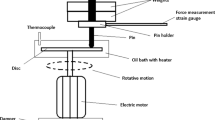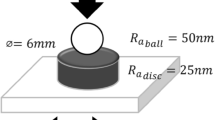Abstract
Fullerene-like WS2 (MoS2) nanoparticles (IF) have been studied in the past. Their efficacy as additives for lubrication fluids has been demonstrated. It was shown that the IF nanoparticles are usually delaminated in the inlet of the smooth contact. Thin sheets of broken IF nanoparticles can be entrapped between the rubbed surfaces and thus favorably affect the friction and the wear. Friction pairs at real mechanical macrosystems are often subjected to friction-induced vibrations. It was shown that the mechanical excitations can improve the supplying and preservation of fluid lubricant film in the interface. It can be hypothesized that under vibrations in a definite range of frequencies and amplitudes, the probability for small IF aggregates to be entrapped into the interface is increased. The main goal of this work was to study the effect of artificial mechanical excitations on the friction and wear of contact pairs rubbed with nanoparticles. In order to avoid friction-induced excitations, a new ball-on-flat friction device was developed. The frequency and the amplitude of the ball were varied using a motion of miniature micromotor attached to the ball holder. The behavior of IF nanoparticles in friction tests with and without external mechanical excitations was compared with the tribological behavior of the contact pair lubricated with pure paraffin oil. It was found that the external mechanical excitation of the mechanical parts rubbed with nanoparticles allows a penetration of these nanoparticles into interface. This effect leads to a remarkable shortening of the run-in period and improves the tribological properties of contact pairs. From the present results it may be anticipated that the accidental friction-induced vibrations, which are determined by the stiffness and damping force of the device, lead to preferential penetration of the IF nanoparticles into the contact area, affecting thereby the tribological behavior of the interface.








Similar content being viewed by others
References
Rapoport L., Leshchinsky V., Volovik Yu., Lvovsky M., Nepomnyashchy O., Feldman Y., Popovitz-Biro R., Tenne R., (2003) Surf. Coat. Tech. 405:163
Rapoport L., Leshchinsky V., Lapsker I., Volovik Yu., Nepomnyashchy O., Lvovsky M., Popovitz-Biro R., Feldman Y., Tenne R. (2003). Wear 255:785
Chhowalla M., Amaratunga G.A.J., (2000). Nature 406:164
Cizaire, Vacher B., Le Mogne T., Martin J.M., Rapoport L., Margolin A., Tenne R., (2002). Surf. Coat. Tech. 160:282
Joly-Pottuza L., Dassenoya F., Belina M., Vachera B., Martin J.M., Fleischer N., (2005). Tribol. Lett. 18:477
Rapoport L., Nepomnyashchy O., Lapsker I., Verdyan A., Moshkovich A., Feldman Y., Tenne R., (2005). Wear 259:703
Rapoport L., Nepomnyashchy O., Lapsker I., Verdyan A., Soifer Y., Popovitz-Biro R., Tenne R., (2005). Tribol. Lett. 19:143
Lehtovaara A., (1987). Wear 115:131
Ko P.L., Taponat M-C., Pfaifer R., (2001). Tribol. Int. 34:7
Broniec Z., Lenkeiwicz W., (1982). Wear 80:261
Polycarpou A.A., Soom A., (1995). J. Tribol. 117:255
Heuberger M., Drummond C., Israelachvili J., (1998). J. Phys. Chem. B 102:5038
Rozman M.G., Urbakh M., Klafter J., (1998). Phys. Rev. E 57:7340
Zaloj V., Urbakh M., Klafter J., (1999). Phys. Rev. Lett. 82:4823
Acknowledgments
We are grateful to Eng. M. Paradny for design of new tribotester. The support of the Nanomaterials company in this research (www.apnano.com) is deeply acknowledged.
Author information
Authors and Affiliations
Corresponding author
Rights and permissions
About this article
Cite this article
Perfiliev, V., Moshkovith, A., Verdyan, A. et al. A new way to feed nanoparticles to friction interfaces. Tribol Lett 21, 89–93 (2006). https://doi.org/10.1007/s11249-006-9017-8
Received:
Accepted:
Published:
Issue Date:
DOI: https://doi.org/10.1007/s11249-006-9017-8




